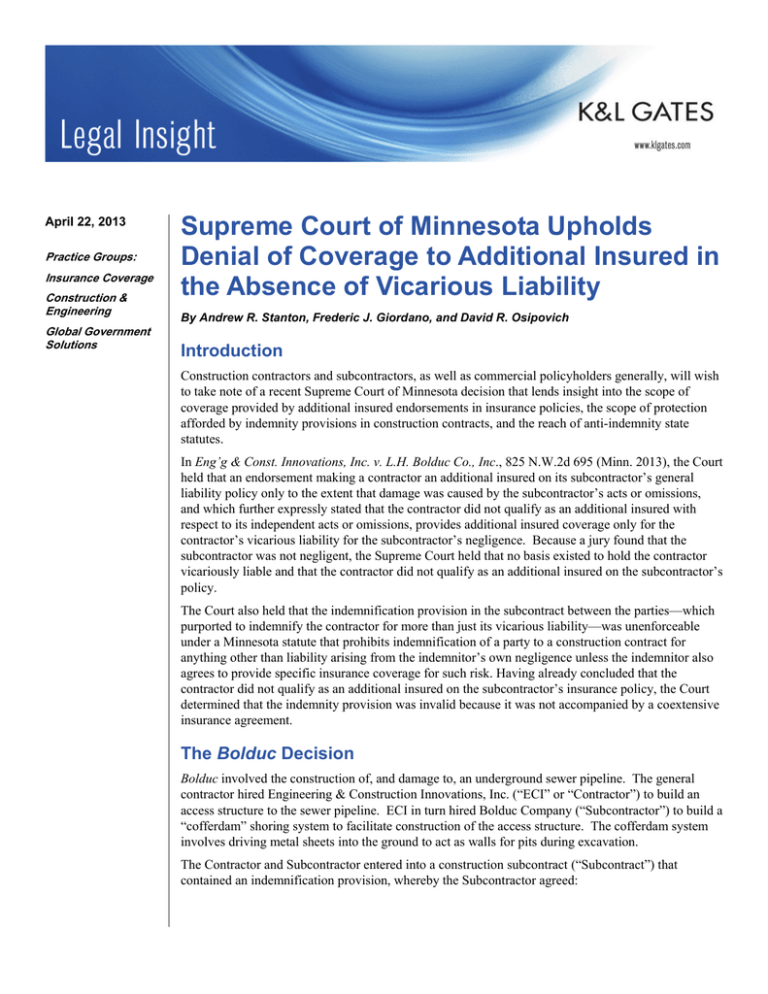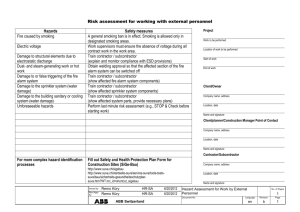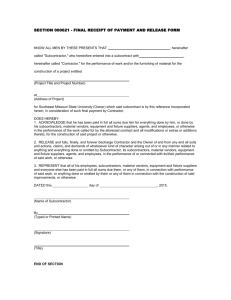
April 22, 2013
Practice Groups:
Insurance Coverage
Construction &
Engineering
Global Government
Solutions
Supreme Court of Minnesota Upholds
Denial of Coverage to Additional Insured in
the Absence of Vicarious Liability
By Andrew R. Stanton, Frederic J. Giordano, and David R. Osipovich
Introduction
Construction contractors and subcontractors, as well as commercial policyholders generally, will wish
to take note of a recent Supreme Court of Minnesota decision that lends insight into the scope of
coverage provided by additional insured endorsements in insurance policies, the scope of protection
afforded by indemnity provisions in construction contracts, and the reach of anti-indemnity state
statutes.
In Eng’g & Const. Innovations, Inc. v. L.H. Bolduc Co., Inc., 825 N.W.2d 695 (Minn. 2013), the Court
held that an endorsement making a contractor an additional insured on its subcontractor’s general
liability policy only to the extent that damage was caused by the subcontractor’s acts or omissions,
and which further expressly stated that the contractor did not qualify as an additional insured with
respect to its independent acts or omissions, provides additional insured coverage only for the
contractor’s vicarious liability for the subcontractor’s negligence. Because a jury found that the
subcontractor was not negligent, the Supreme Court held that no basis existed to hold the contractor
vicariously liable and that the contractor did not qualify as an additional insured on the subcontractor’s
policy.
The Court also held that the indemnification provision in the subcontract between the parties—which
purported to indemnify the contractor for more than just its vicarious liability—was unenforceable
under a Minnesota statute that prohibits indemnification of a party to a construction contract for
anything other than liability arising from the indemnitor’s own negligence unless the indemnitor also
agrees to provide specific insurance coverage for such risk. Having already concluded that the
contractor did not qualify as an additional insured on the subcontractor’s insurance policy, the Court
determined that the indemnity provision was invalid because it was not accompanied by a coextensive
insurance agreement.
The Bolduc Decision
Bolduc involved the construction of, and damage to, an underground sewer pipeline. The general
contractor hired Engineering & Construction Innovations, Inc. (“ECI” or “Contractor”) to build an
access structure to the sewer pipeline. ECI in turn hired Bolduc Company (“Subcontractor”) to build a
“cofferdam” shoring system to facilitate construction of the access structure. The cofferdam system
involves driving metal sheets into the ground to act as walls for pits during excavation.
The Contractor and Subcontractor entered into a construction subcontract (“Subcontract”) that
contained an indemnification provision, whereby the Subcontractor agreed:
Supreme Court of Minnesota Upholds Denial of Coverage
to Additional Insured in the Absence of Vicarious Liability
to protect, indemnify, defend, and hold harmless [the Contractor] … to the fullest extent
permitted by law and to the extent of the insurance requirements below, from and against
(a) all claims, causes of action, liabilities, obligations, demands, costs, and expenses
arising out of… damages to property caused or alleged to have been caused by any act or
omission of [the subcontractor] …, and (b) all damage, judgments, expenses, and
attorney's fees caused by any act or omission of [the Subcontractor] … [The
Subcontractor] agrees to procure and carry until the completion of the Subcontract,
…insurance that specifically covers the indemnity obligations under this paragraph, …
and to name [the Contractor] as an additional insured on said policies.
The Subcontractor also purchased a commercial general liability insurance policy from Travelers
(“Policy”). The Policy contained an additional insured endorsement that provided, in pertinent part:
1. WHO IS AN INSURED—(Section II) is amended to include any person or organization
that you agree in a “written contract requiring insurance” to include as an additional
insured on this Coverage Part, but: (a) Only with respect to liability for … “property
damage”… ; and (b) If, and only to the extent that, the … damage is caused by acts or
omissions of you or your subcontractor in the performance of “your work” to which the
“written contract requiring insurance” applies. The person or organization does not
qualify as an additional insured with respect to the independent acts or omissions of such
person or organization.
The dispute arose out of damage to the sewer pipeline that the Subcontractor caused when it drove a
metal sheet through the edge of the pipeline. The Contractor had provided the template and markings
designating where the Subcontractor was to drive the metal sheets. The Contractor repaired the
damage and then submitted a claim to Travelers for reimbursement. Travelers denied the claim on the
grounds that the Subcontractor did not cause the damage and the Contractor, therefore, did not qualify
as an additional insured on the Policy. This prompted the Contractor to sue both the Subcontractor
and Travelers, alleging that: (1) the Subcontractor’s negligence caused the damage; (2) the
Subcontractor breached the indemnification provision in the contract by failing to indemnify the
Contractor; and (3) Travelers breached the insurance contract when it refused to cover the Contractor
as an additional insured.
The negligence claim was tried to a jury, which found that the Subcontractor was not negligent. The
Contractor then moved for summary judgment on its remaining claims for indemnification from the
Subcontractor and for additional insured coverage from Travelers. The Contractor did not submit a
brief or any evidence in support of its motions. The Subcontractor and Travelers also sought summary
judgment. The trial court granted summary judgment to Travelers and to the Subcontractor and
denied the Contractor’s motions. The Court of Appeals of Minnesota reversed.
The Supreme Court of Minnesota then reversed the Court of Appeals. The Court first held that the
Contractor did not qualify as an additional insured under the Policy. Analyzing the additional insured
endorsement as a whole, including the language that specifically stated no coverage exists with respect
to the Contractor’s independent acts or omissions, the Court concluded the endorsement provided
coverage only for the Contractor’s vicarious liability for the Subcontractor’s negligent acts or
omissions. Although the endorsement referenced only the Subcontractor’s “acts or omissions,” and
not its “negligent acts or omissions,” the Court refused to divorce the language from fault.
The Court reasoned that the Contractor “only qualifies as an additional insured under the [additional
insured] endorsement if several conditions are met. First, as relevant here, [the Contractor] is an
additional insured only ‘with respect to liability for . . . property damage. Second, for [the Contractor]
2
Supreme Court of Minnesota Upholds Denial of Coverage
to Additional Insured in the Absence of Vicarious Liability
to be covered under the policy, such liability for damage must have been ‘caused by acts or omissions
of [the Subcontractor].’ Third, [the Contractor] cannot be an additional insured with respect to
liability caused by ‘the independent acts or omissions of [the Contractor].’” (original quotation marks
omitted).
Focusing on the first condition, the Court noted that the Contractor could have liability for property
damage in one of only three ways: (1) it could have direct liability for the damage as the result of its
own actions; (2) it could have vicarious liability for the damage as the result of the Subcontractor’s
actions; or (3) it could have liability for the damage if it assumed liability for the Subcontractor’s
actions in a contract, e.g. the Contractor’s contract with the project’s general contractor.
The Court found that the Contractor did not satisfy the first condition, because: (1) the additional
insured endorsement explicitly excluded coverage for the additional insured’s own direct liability; (2)
the Contractor could not have vicarious liability for the damage to the pipe as a result of the
Subcontractor’s actions, since the jury had determined that the Subcontractor had not acted
negligently; and (3) even if the Contractor assumed liability for the Subcontractor’s actions, the Policy
did not cover an additional insured’s assumption of liability for another’s conduct. Therefore,
because the Contractor could not establish any liability for property damage that was covered under
the additional insured endorsement, the Court held that the Contractor did not qualify as an additional
insured under the Policy.
The Court further rejected the argument that the endorsement at issue was ambiguous. The Court
distinguished cases from other jurisdictions that found similar endorsements to be ambiguous, because
the endorsement at issue – unlike those examined in the other cases – expressly stated that it provided
no coverage for the additional insured’s acts or omissions.
The Court then held that the indemnification provision in the contract between the Contractor and the
Subcontractor was unenforceable under Minn. Stat. § 337.02. Under the statute, a promise to
indemnify a party to a construction contract for anything other than liability caused by the
indemnitor’s own negligence is not enforceable; that is, the statute forbids a party to a construction
contract from indemnifying the other party for that party’s negligence. An exception exists under
Minn. Stat. § 337.05, however, which provides that Minn. Stat. § 337.02 does not affect the validity of
agreements whereby a promisor agrees to provide specific insurance coverage for the benefit of
others. The Court determined that since there was no finding of negligence against the Subcontractor,
the indemnity agreement at issue would violate Minn. Stat. § 337.02 unless it was accompanied by a
coextensive insurance provision. Having determined already that the Contractor was not insured
under the Policy, the Court held that Minn. Stat. § 337.05 did not save the indemnity provision. The
Court further noted that although an indemnitor is obligated to indemnify an indemnitee for breach of
an agreement to procure specific insurance under another part of Minn. Stat. § 337.05, the Contractor
never raised and therefore waived any such argument.
Conclusion
Bolduc provides valuable instruction for both contractors and subcontractors in the context of
contractual indemnification provisions and additional insured coverage.
First, the decision arises in the context of quite specific policy wording. The Court expressly noted
that its decision depended on the fact that the relevant additional insured endorsement contained
language expressly providing that coverage did not extend to liability for the additional insured’s
independent acts or omissions. Contracting parties should be cognizant that the commonly used
additional insured endorsement on ISO form CG 20 10 07 04 does not contain such extra language.
3
Supreme Court of Minnesota Upholds Denial of Coverage
to Additional Insured in the Absence of Vicarious Liability
Therefore, the Court’s ruling would not necessarily provide guidance for those using the commonlyused ISO form. Nevertheless, parties seeking additional insured coverage should be aware that certain
insurers attempt to include this extra language in additional insured endorsements.
Second, parties to construction contracts should clearly negotiate risk allocation explicitly and up
front, prior to finalizing a contract or procuring an insurance policy. In contracts governed by
Minnesota law, they should ensure that any additional insured coverage is consistent with the parties’
expectations and agree on the scope of indemnity, if any, to be provided under the contract, as well as
ensure that coextensive insurance coverage is placed if they intend indemnity to extend beyond
liability caused by the indemnitor. This will protect both parties’ expectations as respects
indemnification rights and additional insured coverage.
Authors:
Andrew R. Stanton
andrew.stanton@klgates.com
+1.412.355.6583
Frederic J. Giordano
frederic.giordano@klgates.com
+1.973.848.4035
David R. Osipovich
david.osipovich@klgates.com
+1.412.355.6753
Anchorage Austin Beijing Berlin Boston Brisbane Brussels Charleston Charlotte Chicago Dallas Doha Dubai Fort Worth Frankfurt
Harrisburg Hong Kong Houston London Los Angeles Melbourne Miami Milan Moscow Newark New York Orange County Palo Alto Paris
Perth Pittsburgh Portland Raleigh Research Triangle Park San Diego San Francisco São Paulo Seattle Seoul Shanghai Singapore Spokane
Sydney Taipei Tokyo Warsaw Washington, D.C. Wilmington
K&L Gates practices out of 48 fully integrated offices located in the United States, Asia, Australia, Europe, the
Middle East and South America and represents leading global corporations, growth and middle-market companies,
capital markets participants and entrepreneurs in every major industry group as well as public sector entities,
educational institutions, philanthropic organizations and individuals. For more information about K&L Gates or its
locations, practices and registrations, visit www.klgates.com.
This publication is for informational purposes and does not contain or convey legal advice. The information herein should not be used or relied upon in
regard to any particular facts or circumstances without first consulting a lawyer.
©2013 K&L Gates LLP. All Rights Reserved.
4





